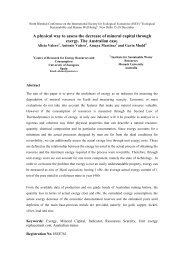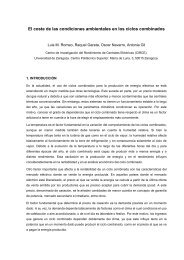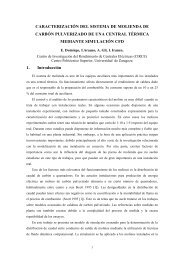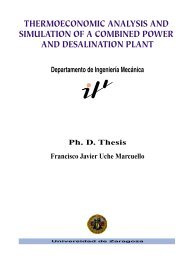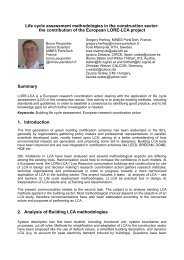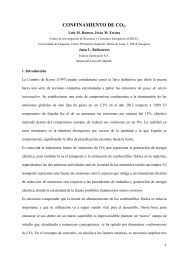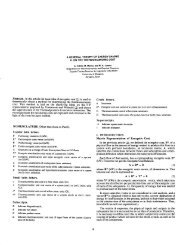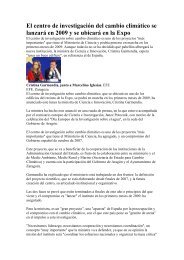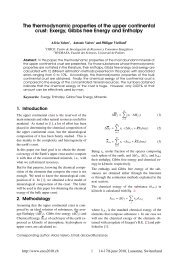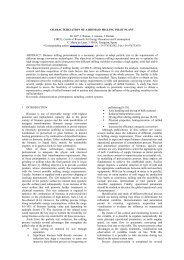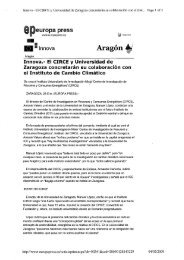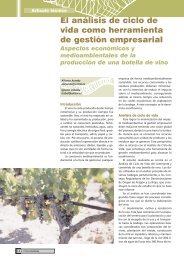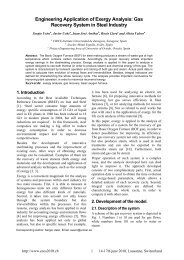APPLYING THERMOECONOMICS TO THE ANALYSIS OF ... - circe
APPLYING THERMOECONOMICS TO THE ANALYSIS OF ... - circe
APPLYING THERMOECONOMICS TO THE ANALYSIS OF ... - circe
Create successful ePaper yourself
Turn your PDF publications into a flip-book with our unique Google optimized e-Paper software.
Table 1. Fuel-Product Table of the food chain (GJ)<br />
0 F 1 F 2 F 3 F 4<br />
F 5<br />
F Total<br />
P0 80 7 15 13.5 0 115.5<br />
P1 0 0 60 0 0 0 60<br />
P2 5 0 0 51.5 3.5 0 60<br />
P3 0 0 0 0 0 1.9 1.9<br />
P4 0 0 0 0 0 3.1 3.1<br />
P5 3.6 0 0 0 0 0 3.6<br />
Total 8.6 80 67 66.5 17 5<br />
Equations (3) and (5) allow computing the production cost. These equations could be also used to decompose the<br />
costs considering the different types of resources. The resource cost vector can be separated into two parts:<br />
fossil biomass<br />
fossil<br />
C0 = C0 + C 0 , where the cost due to fossil fuels in terms of energy resources is C 0 = (0, E02, E03, E04,0)<br />
, and<br />
biomass<br />
the cost due to biomass is C 0 = ( E01,0,0,0,0)<br />
, therefore the production cost due to fossil fuel could be computed as:<br />
fossil<br />
CP= *<br />
P<br />
fossil<br />
C0<br />
(8)<br />
and in the same way the production cost due to biomass is:<br />
biomass<br />
CP= *<br />
P<br />
biomass<br />
C0<br />
(9)<br />
Similar expressions could be used to compute the unitary production cost.<br />
Table 2. Efficiency and production costs of the processes for the base case<br />
Fossil Fuels Biomass Total<br />
Process κ P c (GJ/GJ) P C (GJ) P c (GJ/GJ) P C (GJ) P c (GJ/GJ) C P (GJ)<br />
1 1.33 0.00 0.00 1.33 80.00 1.33 80.00<br />
2 1.12 0.12 7.00 1.33 80.00 1.45 87.00<br />
3 35.00 11.06 21.01 36.14 68.67 47.20 89.68<br />
4 5.48 4.49 13.91 1.51 4.67 5.99 18.58<br />
5 1.39 9.70 34.92 20.37 73.33 30.07 108.25<br />
Total 13.43 35.50 80.00 115.50<br />
In table 2 the efficiency values of each system process are shown. The ratio of the total fossil fuel required per<br />
fossil<br />
calorie consumed is approximately 10:1 ( c P,5<br />
= 9.70 ), a clear indicator of the high inefficiency of the current food<br />
chain. Also note that the production of meat (process 3) requires 2.5 times more fossil energy resources (11.06 vs. 4.49)<br />
than the vegetal production (process 4). By far, the most inefficient process (identified by κ ) is the production of meat.<br />
Starting with the base case we will analyze several scenarios, in order to demonstrate the capabilities of the<br />
thermoeconomic approach for the evaluation of the environmental impact of the food system, and for the identification<br />
of potential improvements.<br />
3.2 Recycling biomass residues<br />
Our aim now is to identify and quantify possible optimization options of the food chain system. In the first scenario,<br />
we are going to analyze the effect of recycling 10% of crop residues (2 GJ) and reusing them as fuel in the next process.<br />
The unit consumption of the first process is reduced to κ 1 = 1.29 and the external resources of the second process to<br />
C 02 = 5. We assume that the distribution ratios and the final demand of the system do not change.<br />
Using Eqn. (3) it is possible to compute the production costs. Since biomass energy and the cost distribution matrix<br />
*<br />
P does not change, the production costs due to biomass do not change either.<br />
890



